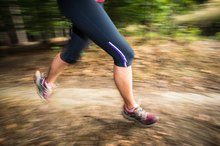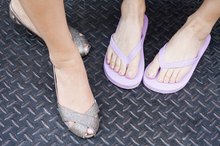Causes of Sharp Heel Pain Felt When Bending
Pain of any kind is worthy of your attention. Pain is your nervous system informing your brain that something is wrong. If you are experiencing sharp heel pain when bending, a few issues should be considered that may help you to decipher what type of help your body needs. If heel pain is severe, chronic or debilitating, contact your healthcare provider right away.
Improper Footwear
Heel pain that is felt when bending may be caused by unhealthy footwear. High heels, though fashionable, are not designed with your foot's health in mind. If you suspect your shoes are causing the problem, opt for shoes that lengthen the Achilles tendon and provide optimal arch support.
Achilles Tendinitis
What Are the Treatments for Thigh Splints?
Learn More
Achilles tendinitis is caused by overuse or injury, according to "The American Physical Therapy Association Book of Body Maintenance and Repair." This painful condition may cause severe heel pain when bending and may take months to heal properly. If you have tendinitis, it is important to avoid re-injuring your tendon by offering your foot plenty of rest and hot compresses. Your doctor or physical therapist can teach you appropriate exercises designed to support Achilles tendinitis.
- Achilles tendinitis is caused by overuse or injury, according to "The American Physical Therapy Association Book of Body Maintenance and Repair."
- If you have tendinitis, it is important to avoid re-injuring your tendon by offering your foot plenty of rest and hot compresses.
Sciatic Nerve
The sciatic nerve is located in your lower back. When misaligned or compressed, shooting pains may be felt in the heel. In cases such as this, chiropractic adjustment or physical therapy may be beneficial.
Shortened Ligaments
Recovery Time for a Torn Plantar Fascia
Learn More
After exercising, ligaments can shorten if not stretched properly. This shortening can cause sharp heel pain. In order to lengthen ligaments safely to prevent this type of pain, you may practice gentle yoga stretches or indulge in a massage offered by a certified massage therapist experienced in sports injuries.
Related Articles
References
- "Bikram Yoga: The Guru Behind Hot Yoga Shows the Way to Radiant Health and Personal Fulfillment"; Bikram Choudhury; 2009
- "The American Physical Therapy Association Book of Body Maintenance and Repair"; Steve Vickery and Marilyn Moffat; 1999
- American Academy of Orthopedic Surgeons. (2017). Heel Pain. https://orthoinfo.aaos.org/en/diseases--conditions/heel-pain
- Tu P, Bytomski JR. Diagnosis of Heel Pain. Am Fam Physician. 2011 Oct 15;84(8):909-16. https://www.aafp.org/afp/2011/1015/p909.html
- Tu P, Bytomski JR. Diagnosis of heel pain. Am Fam Physician. 2011;84(8):909-16.
- Lim AT, How CH, Tan B. Management of plantar fasciitis in the outpatient setting. Singapore Med J. 2016;57(4):168-70. doi:10.11622/smedj.2016069
- Li HY, Hua YH. Achilles Tendinopathy: Current Concepts about the Basic Science and Clinical Treatments. Biomed Res Int. 2016;2016:6492597. doi:10.1155/2016/6492597
- Gulati V, Jaggard M, Al-nammari SS, et al. Management of achilles tendon injury: A current concepts systematic review. World J Orthop. 2015;6(4):380-6. doi:10.5312/wjo.v6.i4.380
- Hong CH, Lee YK, Won SH, Lee DW, Moon SI, Kim WJ. Tarsal tunnel syndrome caused by an uncommon ossicle of the talus: A case report. Medicine (Baltimore). 2018;97(25):e11008. doi:10.1097/MD.0000000000011008
- Mayer SW, Joyner PW, Almekinders LC, Parekh SG. Stress fractures of the foot and ankle in athletes. Sports Health. 2014;6(6):481-91. doi:10.1177/1941738113486588
- Tu P. Heel Pain: Diagnosis and Management. Am Fam Physician. 2018;97(2):86-93.
- Yi TI, Lee GE, Seo IS, Huh WS, Yoon TH, Kim BR. Clinical characteristics of the causes of plantar heel pain. Ann Rehabil Med. 2011;35(4):507-13. doi:10.5535/arm.2011.35.4.507
- Kucuksen S, Karahan AY, Erol K. Haglund syndrome with pump bump. Med Arch. 2012;66(6):425-7.
- Vaishya R, Agarwal AK, Azizi AT, Vijay V. Haglund's Syndrome: A Commonly Seen Mysterious Condition. Cureus. 2016;8(10):e820. doi:10.7759/cureus.820
- Pękala PA, Henry BM, Pękala JR, Piska K, Tomaszewski KA. The Achilles tendon and the retrocalcaneal bursa: An anatomical and radiological study. Bone Joint Res. 2017;6(7):446-451. doi:10.1302/2046-3758.67.BJR-2016-0340.R1
- Helgeson K. Examination and intervention for sinus tarsi syndrome. N Am J Sports Phys Ther. 2009;4(1):29-37.
- Ma DL, Vano-galvan S. Piezogenic pedal papules. CMAJ. 2013;185(18):E847. doi:10.1503/cmaj.121963
- Fritz JM, Mcdonald JR. Osteomyelitis: approach to diagnosis and treatment. Phys Sportsmed. 2008;36(1):nihpa116823. doi:10.3810/psm.2008.12.11
- Yan L, Zong J, Chu J, et al. Primary tumours of the calcaneus. Oncol Lett. 2018;15(6):8901-8914. doi:10.3892/ol.2018.8487
- Narváez JA, Narváez J, Ortega R, Aguilera C, Sánchez A, Andía E. Painful heel: MR imaging findings. Radiographics. 2000;20(2):333-52. doi:10.1148/radiographics.20.2.g00mc09333
- Thomas JL, Christensen JC, Kravitz SR, et al. The diagnosis and treatment of heel pain: a clinical practice guideline-revision 2010. J Foot Ankle Surg. 2010;49(3 Suppl):S1-19. doi:10.1053/j.jfas.2010.01.001
- Noor S, Khan RU, Ahmad J. Understanding Diabetic Foot Infection and its Management. Diabetes Metab Syndr. 2017;11(2):149-156. doi:10.1016/j.dsx.2016.06.023
- Lui E. Systemic causes of heel pain. Clin Podiatr Med Surg. 2010;27(3):431-41. doi:10.1016/j.cpm.2010.04.004
- Podolsky R, Kalichman L. Taping for plantar fasciitis. J Back Musculoskelet Rehabil. 2015;28(1):1-6. doi:10.3233/BMR-140485
- Habets B, Van cingel REH, Backx FJG, Huisstede BMA. Alfredson versus Silbernagel exercise therapy in chronic midportion Achilles tendinopathy: study protocol for a randomized controlled trial. BMC Musculoskelet Disord. 2017;18(1):296. doi:10.1186/s12891-017-1656-4
- Riskowski J, Dufour AB, Hannan MT. Arthritis, foot pain and shoe wear: current musculoskeletal research on feet. Curr Opin Rheumatol. 2011;23(2):148-55. doi:10.1097/BOR.0b013e3283422cf5
- Donley BG, Moore T, Sferra J, Gozdanovic J, Smith R. The efficacy of oral nonsteroidal anti-inflammatory medication (NSAID) in the treatment of plantar fasciitis: a randomized, prospective, placebo-controlled study. Foot Ankle Int. 2007;28(1):20-3. doi:10.3113/FAI.2007.0004
- Sahu RL. Percutaneous planter fasciitis release under local anesthesia: A prospective study. Chin J Traumatol. 2017;20(2):87-89. doi:10.1016/j.cjtee.2017.01.002
- American Academy of Orthopedic Surgeons. (2017). Heel Pain.
- Buchbinder R. (2018). Patient education: Heel and foot pain (caused by plantar fasciitis) (Beyond the Basics). Isaac Z, ed. UpToDate. Waltham, MA: UpToDate Inc.
- Lareau CR, Sawyer G, Wang JH, DiGiovanni CW. Plantar and medial heel pain: diagnosis and management. J Am Acad Orthop Surg. 2014 Jun;22(6):372-80. doi: 10.5435/JAAOS-22-06-372
- Ma DL, Vano-Galvan S. Piezogenic pedal papules. CMAJ. 2013 Dec 10;185(18):E847. doi: 10.1503/cmaj.121963
- Tu P, Bytomski JR. Diagnosis of Heel Pain. Am Fam Physician. 2011 Oct 15;84(8):909-16.
- Vaishya R, Agarwal AK, Azizi AT, Vijay V. Haglund's Syndrome: A Commonly Seen Mysterious Condition. Cureus. 2016 Oct;8(10):e820. doi: 10.7759/cureus.820
Writer Bio
Sara Clement has been a writer, editor and social-media expert since 2002. A regular contributor for publications such as "Exhale," "Reflections of a Butterfly" and "The Giggle Guide," she is currently writing a book about grief and loss and coauthoring a sequel to "Being Ourself." She holds a Bachelor of Arts in premedical science and psychology/education from the University of Montana.






